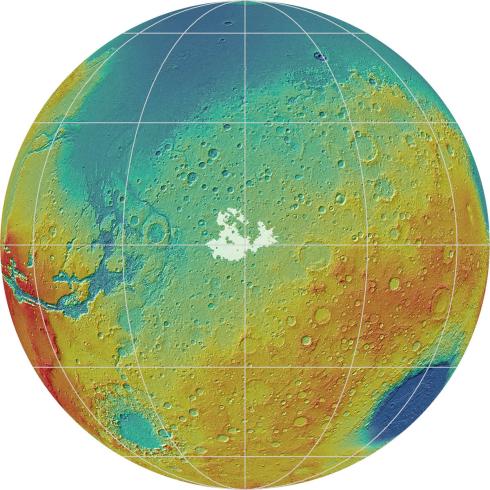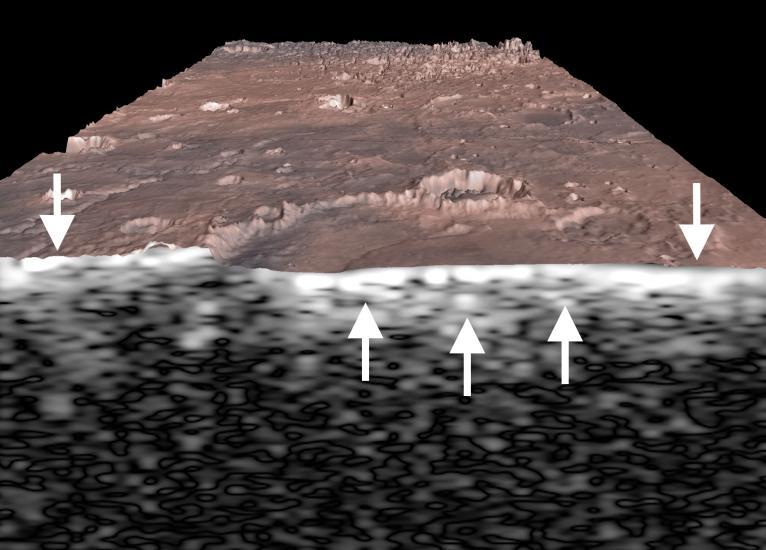Meridiani Planum and the Search for Ice on Mars

Media Inquiries
Public Inquiries
New Findings Published by Smithsonian Scientist Tom Watters
New findings reveal deposits on Mars that could be interpreted to be ice-rich may contain little or no ice at all, based on an analysis of radar sounder data for Meridiani Planum—an area on the planet’s equator being explored by the Opportunity rover. This new insight into Meridiani Planum may help identify areas with and without accessible water ice, a resource critical to future human exploration and possible colonization of Mars. The paper, “Radar Sounder Evidence of Thick, Porous Sediments in Meridiani Planum and Implications for Ice-Filled Deposits on Mars,” is published in the September issue of Geophysical Research Letters by lead author and Smithsonian senior scientist Thomas R. Watters.
Watters and colleagues present new compaction models for materials on Mars that suggest the electrical properties of the deposits of Meridiani Planum, derived from data collected by the Mars Advanced Radar for Subsurface and Ionospheric Sounding (MARSIS) instrument, can be explained without the need for pore-filling ice.
The MARSIS instrument transmits low-frequency radio pulses that penetrate into certain geologic materials and are reflected back where the radio pulses encounter a change in bulk density or composition of the materials. The detection of subsurface reflectors can be used to determine the dielectric constant, a key electrical properties of the materials, by measuring the travel time delays between radar pulses reflected by the surface and subsurface interfaces in Meridiani Planum. This analysis indicates that the deposits of Meridiani Planum have a relatively low dielectric constant. Pure water ice has a low dielectric constant and deposits on Mars with low dielectric constants are often interpreted to be ice-rich. However, newly derived compaction models for Mars indicate that the derived, relatively low dielectric constant of the Meridiani Planum deposits are consistent with a thick sequence of ice-free, porous, windblown sand. Unlike other geologic materials that have been suggested for Meridiani Planum such as volcanic ash or silicate dust, a thick deposit of sand-sized particles on Mars does not compact nearly as much.
“It’s very revealing that the low dielectric constant of the Meridiani Planum deposits can be explained without invoking pore-filling ice,” said Watters. “Our results suggest that caution should be exercised in attributing non-polar deposits on Mars with low dielectric constants to the presence of water ice.”
Watters is a scientist in the Center for Earth and Planetary Studies at the National Air and Space Museum. The MARSIS radar sounder, on board the Mars Express spacecraft, is managed by the Agenzia Spaziale Italiana (ASI) and NASA. The Mars Express mission is managed and operated by the European Space Agency. MARSIS was developed by the University of Rome, Italy, in partnership with NASA’s Jet Propulsion Laboratory in Pasadena, California.
The National Air and Space Museum building on the National Mall in Washington, D.C., is located at Sixth Street and Independence Avenue S.W. The museum’s Steven F. Udvar-Hazy Center is located in Chantilly, Va., near Washington Dulles International Airport. Attendance at both buildings combined was 8.5 million in 2015, making it the most visited museum in America. The museum’s research, collections, exhibitions and programs focus on aeronautical history, space history and planetary studies. Both buildings are open from 10 a.m. until 5:30 p.m. every day (closed Dec. 25).
# # #





